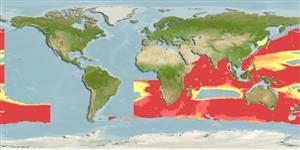Common names from other countries
>
Myctophiformes (Lanternfishes) >
Myctophidae (Lanternfishes) > Lampanyctinae
Etymology: Lampanyctus: Greek, lampas, -ados = torch + Greek, nykte = night (Ref. 45335).
More on author: Fowler.
Environment: milieu / climate zone / depth range / distribution range
Οικολογία
Θαλασσινό(ά) βαθυπελαγικό(ς); ωκεανόδρομο(ς) (Ref. 51243); εύρος βάθους ? - 1757 m (Ref. 280). Deep-water
Indo-West Pacific: Agulhas Current and off the west coast in Agulhas Water pockets (South Africa); also in tropical and subtropical waters between the South China Sea and the western Indian Ocean. Reported from Japan (Ref. 559) and Taiwan (Ref. 39633).
Μέγεθος / Βάρος / Age
Maturity: Lm ? range ? - ? cm
Max length : 7.0 cm SL αρσενικό/απροσδιόριστο; (Ref. 4066)
Short description
Κλείδες προσδιορισμού | Μορφολογία | Μορφομετρία
Ραχιαίες άκανθες (συνολικά) : 0; Μαλακές ραχιαίες ακτίνες (συνολικά) : 12 - 14; Εδρικές άκανθες: 0; Μαλακές εδρικές ακτίνες: 16 - 19. Anal organs 13-14; the elevated, anteriorly displaced second ventral organ (anterior of the vertical from first ventral organ) and the low anal organ and gill raker counts easily separate this species from all other congeners (Ref. 39633).
High-oceanic and mesopelagic; occurs in the upper 212 m at night.
Life cycle and mating behavior
Maturities | Αναπαραγωγή | Spawnings | Egg(s) | Fecundities | Προνύμφες
Hulley, P.A., 1986. Myctophidae. p. 282-321. In M.M. Smith and P.C. Heemstra (eds.) Smiths' sea fishes. Springer-Verlag, Berlin. (Ref. 4066)
IUCN Red List Status (Ref. 130435)
CITES (Ref. 128078)
Not Evaluated
Threat to humans
Harmless
Human uses
Εργαλεία
Special reports
Download XML
Διαδικτυακές πηγές
Estimates based on models
Preferred temperature (Ref.
115969): 2.6 - 5.9, mean 3.9 (based on 589 cells).
Phylogenetic diversity index (Ref.
82804): PD
50 = 0.5000 [Uniqueness, from 0.5 = low to 2.0 = high].
Bayesian length-weight: a=0.00479 (0.00217 - 0.01054), b=3.16 (2.98 - 3.34), in cm Total Length, based on LWR estimates for this Genus-body shape (Ref.
93245).
Τροφικό Επίπεδο (Ref.
69278): 3.2 ±0.3 se; based on size and trophs of closest relatives
Ελαστικότητα (Ref.
120179): Υψηλό, ελάχιστος χρόνος για διπλασιασμό πληθυσμού < 15 μήνες (Preliminary K or Fecundity.).
Fishing Vulnerability (Ref.
59153): Low vulnerability (10 of 100).
